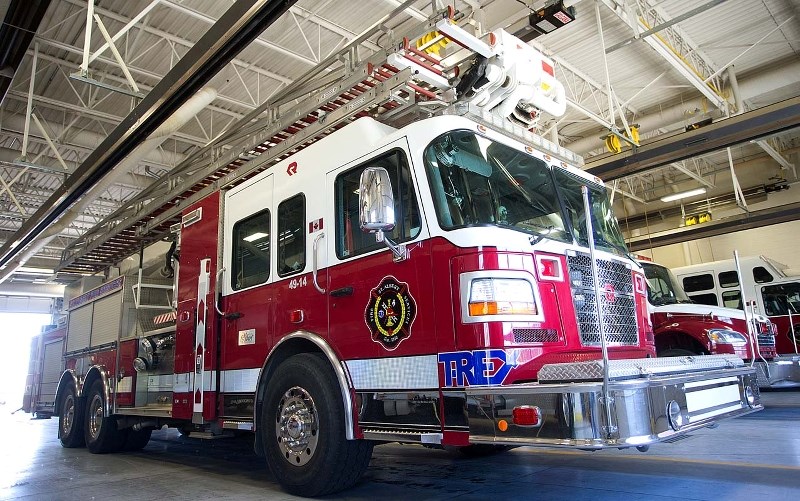Councillors have postponed making a decision to purchase an aerial fire truck to replace a lemon purchased in 2009.
On Tuesday council voted in favour of delaying a decision on submitted bids to replace the city’s only aerial fire truck, asking staff to provide more analysis between the two choices offered and to check with Edmonton to see if one of its old trucks could be leased or purchased for less money.
The aerial unit is needed for buildings with footprints of 25,000 square feet or more or that have more than two storeys, said fire chief Ray Richards. Richards said the fire department knows of at least 152 buildings in St. Albert – including high schools, the hospital, condo buildings or big box stores like Costco – that would ideally need the aerial unit to elevate the water distribution if there was a fire.
But the truck is used for more than just those calls.
“It rolls on any structural fire, so it needs to be drivable today, tomorrow and beyond,” said Richards.
The current unit was purchased new in 2009 for $1.14-million and put into operation in March 2010. Since then it’s spent a good deal of time in the shop, getting about $200,000 in warranty repairs and another $160,000 spent from the city’s public work’s department budget on repairs.
A report to council in December said between July 2012 and October 2014, the unit had been out of service 70 per cent of the time, and in the 12 months before the report, in the shop 95 per cent of the time.
City staff proposed in December to purchase a new truck for an estimated $900,000, and brought back a funding strategy for council’s approval in February. The price ended up going up in part due to a falling Canadian dollar.
The funding strategy suggested the cost to buy a new unit would be $1.47-million. The proposal was to divide that cost between $297,000 from an equipment replacement reserve, pull another $673,000 from the city’s stabilization fund and estimated a $500,000 trade-in value. Council approved and bidding was opened.
On Tuesday, council was told there were two compliant bids. One offered a much-lower trade-in value than expected, and the other didn’t offer a trade-in at all. Staff were suggesting they take the latter and try and sell the truck through other means, paying the entire $1.46-million price tag through the two reserves.
Instead, council ended up postponing the decision. Richards was faced with questions about how often the truck is used, if one could be shared with Edmonton, or rely on mutual aid agreements with other municipalities, whether or not an older used truck could be purchased and other questions, such as if the current truck could be donated to a developing country.
Some councillors questioned if staff had done their due-diligence in providing options, with Coun. Cam MacKay quickly searching for used trucks on the web and wondering why aerials are hard to come by.
“I feel like we’re in a giant mess,” said Coun. Sheena Hughes. She eventually moved to postpone the matter and asked for a buy or lease option to be explored with Edmonton for council’s information.
MacKay wondered about partnering up with Edmonton somehow, like chipping in for a truck that St. Albert uses sometimes. Mayor Nolan Crouse asked about buying one from Edmonton, something Hughes used in her motion.
Coun. Tim Osborne wanted to know if the idea of pursuing legal action had been explored with regards to the ongoing problems with the truck. Legal action against the manufacturer or distributor had been examined but had a low probability of success, a report to council shows. The city was able to get an extended warranty that helped cover repair costs between March 2013 and March 2014.
While Richards said there were about six fires that needed the aerial last year, the truck actually goes out regularly as part of their response protocol – or at least, it does when it’s working.
In a follow-up interview, Richards said a city the size of St. Albert requires at least one aerial unit. Many of a similar size in Alberta have two, he said, noting recent research he’d done.
“If we had none in the city it could potentially impact both residential and commercial (insurance) rates,” he said.
The unit is used for firefighting but also for rescue.
There have been fires where the aerial truck could have been used when it was out of service, he said.
“Over that period of time, clearly, we’ve had fires where it could have been used but it just wasn’t available,” Richards said. “What it means for the house fire where it could have been used when it was out of service, it just meant it took more people to do the things that this thing does very easily.”
The unit was currently working this week, and Richards said St. Albertans shouldn’t worry that they can’t fight fires at all if it’s out of service. It just means a change in tactics – and maybe some more loss due to fire than there would have been otherwise.
“We’ve got pumps and we’ve got people, we do have mutual aid and that’s how we cover when the unit is down, and even for large fires we will call in mutual aid, the only challenge there is that mutual aid is going to be 15, 20, 25 minutes away … so our crews change their strategy somewhat,” Richards said. “We might have a larger fire loss because of it, which is our concern.”




